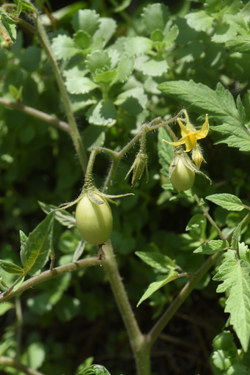Green wall growing veggies at CMU
Posted on: July 5, 2018 | Written By: Doug Oster |
To say Chris Leininger’s outside office windows are unique is an understatement, as they are covered with vegetables, herbs and flowers growing vertically at the Carnegie Mellon University campus. Tiny bright green cherry tomatoes share space with flowering pole beans and peppers on this green wall.

Chris Leininger is a PhD. candidate at CMU who is experimenting with living walls not only to cool buildings, but also harvest produce.

Chris Leininger is a PhD. candidate at CMU who is experimenting with living walls not only to cool buildings, but also harvest produce. Cherry tomatoes and roma varieties are thriving on the wall.
The Ph.D. candidate has been interested in environmental design for decades, using dead plants for straw bale and timber frame construction and now is testing a fascinating new project as a way to earn his Ph.D.
“Design and architecture can make a more beautiful environment,” he says, smiling. Over the years, he has been inspired by students and teachers, which has led to this study. While teaching at Slippery Rock University in the sustainable systems program, a student had an idea to build a green wall called a living facade, which intrigued Leininger. He was also motivated by a presentation that showed green roofs — when done right — could completely mitigate the heat island effect in conventional buildings. That’s when he changed his way of thinking.
“I shifted from thinking about dead plants as structural materials in buildings to living plants on the facade as a way to replace fossil fuel energy,” he says, “to provide cooling and other benefits for the building.”
The focus of his study is to see if a green facade can be developed that is reliably food producing and uses captured rain water, while simultaneously reducing the temperature of the building, which would in turn lower the energy needed for cooling. Another aspect of his research looks to see if the plants are also having a positive impact in cleaning the air.
He’s already working in an innovative environment at The Robert L. Preger Intelligent Workplace on the fourth floor of the Margaret Morrison Carnegie Hall at the university. It was opened in 1997 as a demonstration of something called the systems integration design approach to commercial design and construction of building in the 21st century. The building space has built-in flexibility and adaptability and is used to test new ideas about the work environment. Growing tomatoes on the outside of his office vertically in boxes attached to the facade is certainly a new idea. It’s the first such study on food-producing green facades he’s been able to discover in his research.
The system is a series of wooden panels stacked vertically on a trellis system. The pine panels are one foot by one foot by eight inches deep. The pine will eventually rot away and go to the compost pile. The boxes are covered with hardware cloth, a type of thick screening. The hardware cloth also is attached to the facade above the boxes for the vines to ramble on. The boxes are filled with a custom-made medium that includes compost, leaves, wood chips, clay-based soil and some top soil, added for its local microorganisms. His rain barrels can pump water with solar energy to the plants, but since he’s there every day, he hand waters, too. The rain barrels usually produce enough water, but last year during a 39-day rainless stretch, Leininger was forced to use tap water.

Chris Leininger is a PhD. candidate at CMU who is experimenting with living walls not only to cool buildings, but also harvest produce. This is just some of the produce he’s harvested from the wall one season.
Hybrid cherry and roma tomatoes fill the boxes along with deep green hot and sweet peppers. ‘Kentucky Wonder’ and Scarlet Runner’ pole beans climb the trellis next to many herbs and even some pretty red, vining mandevilla plants. Leininger has saved seeds from the beans to replant each season. They are the happiest growing in the boxes along with drifts of bright green sedum in the lower boxes.
This is the fifth year he’s been growing the plants, and initial findings are hopeful. Although he’s had ups and downs with food production over the years, he admits to not being a horticulturist but is an enthusiastic gardener. The goal was never to produce tons of food, but to see if enough could be garnered from the vertical garden along with the other benefits of the system.
“I’m sure I’ve made a lot of mistakes,” he says, “and I’ve probably done some things in less than ideal fashion.”
One year he harvested 14 pounds of produce from 35 square feet, which would be about a half a pound per square foot.
“It’s not a huge amount,” Leininger says. “The other benefit is that it’s locally produced; for instance, a restaurant could use this kind of a system for garnishes for salads.”
There are billions of square feet of facades which could be converted to gardens, he adds.
“It’s almost like found land that you could now make productive,” he says.
The system also collects storm water, is beautiful, increases biodiversity and habitat and can greatly reduce the temperature of the building. According to his research lessons, air temperatures are 20-25 degrees lower at the facade. Infrared photographs show radiant temperatures reflected off the facade are 50 to 70 degrees less.
“I don’t have to burn coal to cool my building, I can grow a garden to cool my building,” he says proudly.
Green building rating systems like LEED began the documentation of the environmental impact of building and trying to minimize the negatives. Then there’s the Living Building Challenge, creating buildings that are net zero energy, water or waste. Phipps Center for Sustainable Landscapes and the Pittsburgh Parks Conservancy’s Frick Environmental Center have both been awarded Living Building Challenge certification. But Leininger and his colleagues think that a structure can get even more environmentally friendly.
“Why shouldn’t buildings be able to produce clean water, clean energy, clean food,” he asks. “Why can’t they produce good soil through compost programs like we have here at Carnegie Mellon?”
It’s an eco-systems approach to the design, function, operation and maintenance of the built environment, Leininger added.
“The fun part for me is being able to come through this highly regarded institution and focus on research that engages nature, plants, food production and things that are directly beneficial to our most pressing immediate urban needs,” he says. “To me that’s really exciting and enjoyable.”
Looking over the green wall set off by bright yellow tomato blossoms and glowing red tubular mandevilla flowers, Leininger smiles and says, “It does really create an attractive, healing, regenerative environment.”
Doug Oster is editor of Everybody Gardens, a website operated by 535Media, LLC. Reach him at 412-965-3278 or doster@535mediallc.com. See other stories, videos, blogs, tips and more at everybodygardens.com.